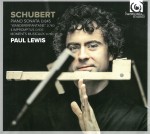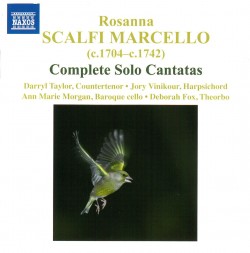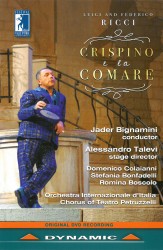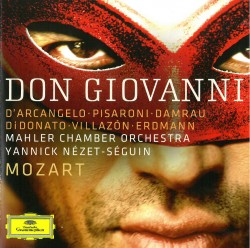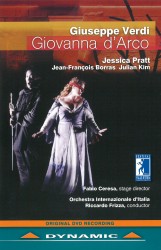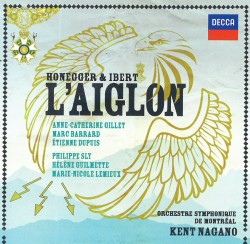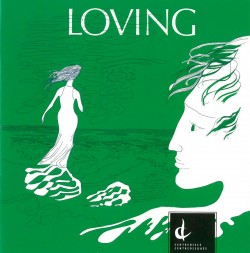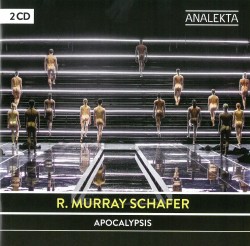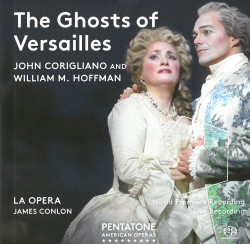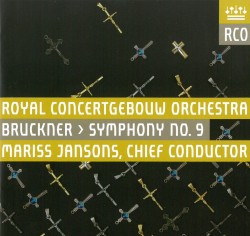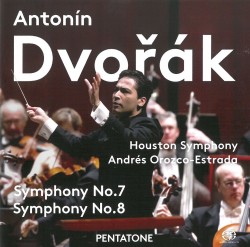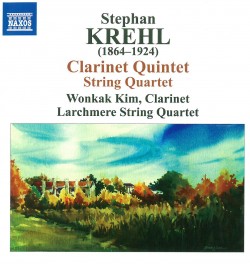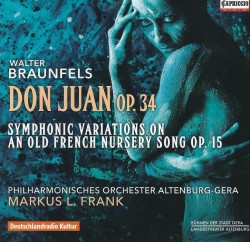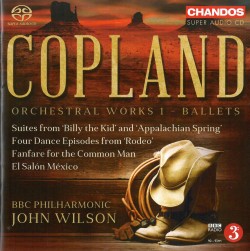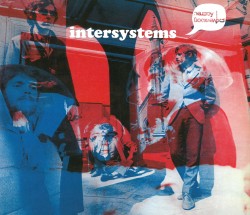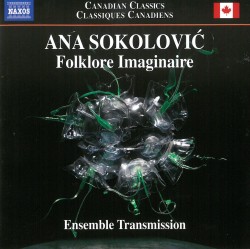Keyed In - May 2016
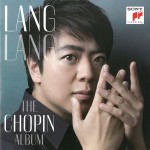 Lang Lang’s new release The Chopin Album (Sony 8872548960) is a demonstration of his belief that Chopin is all about emotion. The sheer amount of it that he releases from the dense black spots on Chopin’s pages is a wonder.
Lang Lang’s new release The Chopin Album (Sony 8872548960) is a demonstration of his belief that Chopin is all about emotion. The sheer amount of it that he releases from the dense black spots on Chopin’s pages is a wonder.There is something about the way the human brain is wired that allows gifted pianists to play the way they do. A single player can sound like two people, with hands at every point of the keyboard, drawing melodies out of dense swirls of elaborate runs and arpeggios. The scale of this genius grows when one considers that composer-pianists first conceived such phenomena in their minds then coded them to paper fully expecting their conceptions to be interpreted accurately. Pianistic genius is something shared inexplicably between creator and performer. Obviously Lang Lang is a pianist who really connects this way with Chopin.
Because technique has long since ceased being a barrier, Lang Lang concentrates on content. He plays the 12 Etudes Op.25 with complete commitment to the power of both force and fragility. It would be difficult to find another performance where emotional poles are so distant from each other. The Nocturnes in E-Flat Major Op.55 No.2 and F Major Op.15 No.1 are amazing examples of this approach.
Every track is a treasure and the listening experience simply begs to be repeated.
Review
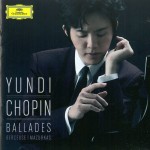 I wrote about Yundi a few months ago and now have another Chopin disc by this prolific recording artist. to enjoy. A prolific recording artist Chopin Ballades, Berceuse, Mazurkas (Deutsche Grammophon 4812443) is his 19th CD. Yundi is a direct player who doesn’t venture far beyond the notes on the page unless Chopin suggests the risk promises some reward. Yundi seems to calculate his artistic risks carefully. In the Four Ballades we have impeccable playing through the first three but No.4 in F Minor Op.52 is altogether different. Here Yundi moves the expressive boundaries out further based on the potential of the emotional content of Chopin’s melodic material. It’s a brilliant and successful choice that speaks to Yundi’s maturity.
I wrote about Yundi a few months ago and now have another Chopin disc by this prolific recording artist. to enjoy. A prolific recording artist Chopin Ballades, Berceuse, Mazurkas (Deutsche Grammophon 4812443) is his 19th CD. Yundi is a direct player who doesn’t venture far beyond the notes on the page unless Chopin suggests the risk promises some reward. Yundi seems to calculate his artistic risks carefully. In the Four Ballades we have impeccable playing through the first three but No.4 in F Minor Op.52 is altogether different. Here Yundi moves the expressive boundaries out further based on the potential of the emotional content of Chopin’s melodic material. It’s a brilliant and successful choice that speaks to Yundi’s maturity.
Similarly, the Four Mazurkas Op.17 give us the familiar rhythmic pulse of one of Chopin’s favourite dance forms. But Chopin expresses so much more than just dance. No.3 in A-Flat Major begins to open the languorous dark side of this music and Yundi exploits this with great care. No.4 in A Minor is, however, a powerful exploration of the rich melancholy Chopin weaves so skillfully. Yundi glides through this making the most of every possible hesitation and lingering idea. It’s a magical way to end the program.
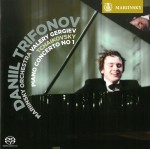 Russian pianist Daniil Trifonov has all the fire of his mid-20s age. On Tchaikovsky – Piano Concerto No.1, Mariinsky Orchestra; Valery Gergiev (Mariinsky MAR 0530) Trifonov leaves no doubt that he can conquer the most difficult passages Tchaikovsky has written into the score. Trifonov and Gergiev take many of these tutti passages at blazing speeds, making them truly exciting. But all this would be nothing if Trifonov couldn’t retreat, as he does so effectively, into the concerto’s introspective moments. The second movement offers a generous sanctuary for this repose, where Trifonov shifts between wistfulness and playfulness. But it’s the two outer movements that really underscore the contrasts of Tchaikovsky’s large-scale vocabulary. The whole concerto frequently has a balletic feel, which is no surprise with Gergiev conducting.
Russian pianist Daniil Trifonov has all the fire of his mid-20s age. On Tchaikovsky – Piano Concerto No.1, Mariinsky Orchestra; Valery Gergiev (Mariinsky MAR 0530) Trifonov leaves no doubt that he can conquer the most difficult passages Tchaikovsky has written into the score. Trifonov and Gergiev take many of these tutti passages at blazing speeds, making them truly exciting. But all this would be nothing if Trifonov couldn’t retreat, as he does so effectively, into the concerto’s introspective moments. The second movement offers a generous sanctuary for this repose, where Trifonov shifts between wistfulness and playfulness. But it’s the two outer movements that really underscore the contrasts of Tchaikovsky’s large-scale vocabulary. The whole concerto frequently has a balletic feel, which is no surprise with Gergiev conducting.
While the concerto gave us all the muscle of this young pianist, the rest of the disc is a moving testament to his gift for tenderness. The Chopin Barcarolle, and the Shubert/Liszt Frühlingsglaube are played with great vulnerability. Die Forelle, similarly moves with great care, but impressive technique, through Liszt’s rapid and skittish portrayals of the legendary trout.
The final track is wisely given to Liebeslied (Widmung) wherein Liszt speaks to Schubert’s original idea in broader more embellished keyboard style and creates a grand final impact by building the simple musical idea into a great edifice. Trifonov really shines in these smaller scale works with flawless technique, intelligent and deeply believable interpretations.
Review
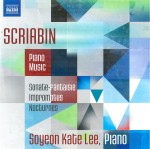 Korean-American pianist Soyeon Kate Lee has a modest discography but a talent that deserves more exposure. Her newest recording Scriabin – Piano Music (Naxos 8.573527) is a deliberate choice of the composer’s lesser known works, and as such, a wonderful find. Scriabin’s language for the piano has its well-known Chopinesque accent. Much of it is late 19th-century but a few pieces are from the early 20th. The Two Pieces, Op.57 (1908) are the most contemporary of the set and Lee delights in all the gentle angularities of Scriabin’s melodies. She is always completely certain of where the most important material lies and highlights it artfully, even if only a passing note. Lee is very generous with her rubato, taking all the time to exploit hesitant moments for their greatest effect. Her consistently fluid technique is a pleasure to experience, especially in the Nocturne in D-Flat Major Op.9 No.2, written for the left hand alone.
Korean-American pianist Soyeon Kate Lee has a modest discography but a talent that deserves more exposure. Her newest recording Scriabin – Piano Music (Naxos 8.573527) is a deliberate choice of the composer’s lesser known works, and as such, a wonderful find. Scriabin’s language for the piano has its well-known Chopinesque accent. Much of it is late 19th-century but a few pieces are from the early 20th. The Two Pieces, Op.57 (1908) are the most contemporary of the set and Lee delights in all the gentle angularities of Scriabin’s melodies. She is always completely certain of where the most important material lies and highlights it artfully, even if only a passing note. Lee is very generous with her rubato, taking all the time to exploit hesitant moments for their greatest effect. Her consistently fluid technique is a pleasure to experience, especially in the Nocturne in D-Flat Major Op.9 No.2, written for the left hand alone.
While Scriabin made little of the dance nature of his Mazurkas and Polonaises, Lee nevertheless chooses to underscore this with a subtle pulse on the beat of certain measures as if to remind us of the missing choreography. She closes her recording with a remarkable piece Scriabin wrote at age 11. This Canon in D Minor already bears the distinctive melancholy of its Russian composer. This is a very engaging recording for its fine repertoire choice and thoughtful playing.
Not many pianists can boast of having performed all the Beethoven concertos in a single season. Paul Lewis can. When one considers this, his 15 recordings, and sees his discography is mostly Schubert and Beethoven, we begin to understand this artist. While such specialization early in a career may be unusual, one can’t argue with the results.
Lewis in Schubert – Piano Sonata D.845 (Harmonia Mundi HMC 902136.37) leaves no doubt that he is a master of Schubert’s musical language. His grasp of the large forms like the Wanderer Fantasy in C Major Op.15 D760 and the Sonata No.16 in A Minor Op.42 D845 is often orchestral in conception.
The smaller forms like the Four Impromptus Op.Posth.142 D935 are wonderfully fresh and credible. The Impromptu No.2 in A-Flat Major is moving in its simplicity and fluid middle section. No.4 in F Minor is often Listzian in its delivery, suggesting that Schubert was a finer pianist than history might have allowed.
Lewis plays the Six Moments Musicaux Op.94 D780 in a beautifully contemplative posture, especially the final Allegretto. It’s a memorable performance.
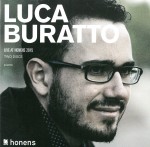 Italian pianist Luca Buratto is the 2015 Laureate of the Honens Piano Competition. His two-disc set Live at Honens 2015 (Honens 201601CD) of performances at the competition is a reminder of how well-rounded the judges expect the winner to be. The latest “Complete Pianist” has assembled a live performance program of impressive variety to demonstrate his abilities as soloist, accompanist and ensemble player.
Italian pianist Luca Buratto is the 2015 Laureate of the Honens Piano Competition. His two-disc set Live at Honens 2015 (Honens 201601CD) of performances at the competition is a reminder of how well-rounded the judges expect the winner to be. The latest “Complete Pianist” has assembled a live performance program of impressive variety to demonstrate his abilities as soloist, accompanist and ensemble player.
The standard repertoire items for solo piano reveal Buratto’s unerring grasp of the genre. His inspired approach to the final movement of Schumann’s Fantasy in C Major Op.17 moves it to a new level of dark and rich solemnity. He delivers Debussy’s L’isle joyeuse with a rare sparkle and remarkable firepower for the ending. Etudes 15 and 16 for Piano by György Ligeti are breathtaking in their closing measures, restating at maniacal speed, the opening ideas originally heard at a meditative pace. This is brilliant interpretation and performance.
Buratto’s recording includes songs by Viardot and Obradors, sung by Soprano Isabel Bayrakdarian, Mozart’s “Kegelstatt” Trio K498 for piano, viola and clarinet and other works variously combining the voice with the wind and string instruments.
The true highlight of the set is, however, the Hindemith Sonata for viola and piano in F Major Op.11 No.4. Buratto and violist Hsin-Yun Huang understand this music at the deepest level, capturing all the melodic beauty in Hindemith’s writing. This is especially effective in the second and third movements where the theme and variation format offer seemingly endless opportunity for restatement. The 2015 Honens recording is a must-have.
Review
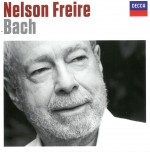 Now in his early 70s, Brazilian pianist Nelson Freire has recorded most of the classical and romantic repertoire. His latest recording Bach Piano Works (Decca 478 8449) is a reminder of how universal an artist he is. While not regarded as a specialist in the historical performance practice of baroque keyboard repertoire, he is nevertheless highly credible because of his interpretive maturity.
Now in his early 70s, Brazilian pianist Nelson Freire has recorded most of the classical and romantic repertoire. His latest recording Bach Piano Works (Decca 478 8449) is a reminder of how universal an artist he is. While not regarded as a specialist in the historical performance practice of baroque keyboard repertoire, he is nevertheless highly credible because of his interpretive maturity.
All the Bach on this recording is clean and unpedalled, as it should be. The wild sweeps of the Chromatic Fantasia and Fugue in D Minor BWV903 are beautifully conceived, using only a minimum of the piano’s natural resonance. By contrast, Freire steeps himself in all the available tonal richness of the Andante from the Concerto in D Minor BWV974.
The unidentified instrument used in the recording surrenders a lovely mellow ring to Freire’s touch. His remarkable technique is at once light and fluid. He’s masterful in knowing how to culminate the hammer strike through each keystroke to achieve the precise colour he wants. The Allemande of the Partita No.4 in D Major BWV828 is an arresting example of this keyboard caress. The closing Gigue is a rapid cascade of crisp articulated notes impeccably phrased.
Equally impressive is his shift to the modern transcriptions of Jesu, Joy of Man’s Desiring by Myra Hess and two chorales by Ferruccio Busoni. The stylistic shift is flawless while preserving the Germanic baroque discipline of Bach’s melodies and modulations. This is a performance of exceptional beauty.
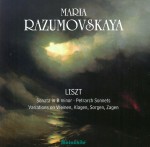 All performance art benefits from the companionship of passion and intellect. When a highly intelligent artist with impressive academic credentials undertakes a quest to know a composer at the most essential level, we have to listen. In her new recording Liszt – Sonata in B Minor, Petrarch Sonnets, Variations on Weinen, Klagen, Sorgen, Sagen (Malachite Cu20301), Maria Razumovskaya informs her pianistic virtuosity with a profound understanding of Liszt and the nature of his music.
All performance art benefits from the companionship of passion and intellect. When a highly intelligent artist with impressive academic credentials undertakes a quest to know a composer at the most essential level, we have to listen. In her new recording Liszt – Sonata in B Minor, Petrarch Sonnets, Variations on Weinen, Klagen, Sorgen, Sagen (Malachite Cu20301), Maria Razumovskaya informs her pianistic virtuosity with a profound understanding of Liszt and the nature of his music.
The Three Petrarch Sonnets are exquisitely cast in a pictorial yet spiritual way. Razumovskaya fully grasps the pilgrimage Liszt undertook both physically and creatively. The Sonnets have a simple and ethereal quality in their performance that is quite remarkable. It’s an approach that’s very similar to her treatment of the Variations on Weinen, Klagen, Sorgen, Sagen. So much of this piece is played introspectively. It ends with very a moving statement of the Bach chorale.
The anchor of Razumovskaya’s program is, of course, the B Minor Sonata S178. This may possibly be the least tormented and most contemplative performance I have heard. There is a confidence of statement found throughout even the darkest and most troubled passages which seem to point naturally to all the moments of modal and emotional resolution. It’s an effective interpretation based on a direct inquiry of Liszt’s intention at every moment and constantly reconciled with the person Razumovskaya knows him to be. It’s a very satisfying approach, the companionship of passion and intellect.


